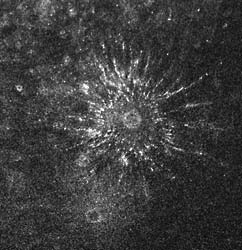
This unnamed crater on Mercury, 85 kilometers across, looks like a twin of the lunar crater Tycho. Radar soundings by the Arecibo radio telescope in mid-2001 revealed the 900-km-wide splash of bright rays — an indication that the crater is geologically very young.
Courtesy John K. Harmon (National Astronomy and Ionosphere Center).
During the mid-1970s, fortuitous geometry allowed Mariner 10 to zip by Mercury three times in a 12-month period. But that same geometry precluded the spacecraft from seeing almost half of the innermost planet's surface — a "terra incognita" that remains virtually unknown nearly three decades later.
However, as radar facilities on Earth continue to probe the unseen territory with ever-improving resolution, Mercury is slowly giving up its secrets. Several days of observations made last June and July with the 305-meter Arecibo dish in Puerto Rico recorded details only a few kilometers across and turned up a number of surprises.
Nearly straddling the equator on Mercury's unseen hemisphere is a prominent, 85-kilometer-wide crater sitting in a splash of bright rays some 900 km across. According to John K. Harmon (National Astronomy and Ionosphere Center) and Donald B. Campbell (Cornell), the rays are extremely rough — jumbles of rock and dust thrown out by the impact — which makes them excellent reflectors of Arecibo's radar pulses. The rays look so fresh, in fact, that this crater may be much younger than similarly sized Tycho, which was blasted out of the lunar landscape 109 million years ago. Harmon notes that the unnamed Mercurian crater had been seen in previous radar campaigns, but with only a tenth as much resolution.
Fortunately, two new spacecraft will soon be en route to mysterious Mercury. NASA's mission, MESSENGER, calls for a heavily instrumented craft to slip into orbit around the planet in April 2009 and conduct comprehensive mapping surveys and compositional assays. That same year the European Space Agency plans to dispatch its BepiColombo spacecraft, which honors Italian space scientist Guiseppe "Bepi" Colombo (1920–1984). Upon arrival at Mercury after a 2½-year flight, it will separate into one orbiter to study the globe, a second orbiter to monitor the magnetic field, and a small lander to analyze the surface rocks.
 0
0
Comments
You must be logged in to post a comment.